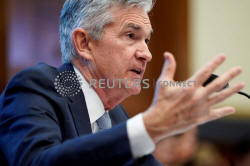For Fed's Powell, a gap with markets and Trump may need explaining
 Send a link to a friend
Send a link to a friend
 [June 18, 2019] By
Howard Schneider and Ann Saphir [June 18, 2019] By
Howard Schneider and Ann Saphir
WASHINGTON/SAN FRANCISCO - (Reuters) - Bond
investors expect an aggressive set of U.S. interest rate cuts this year,
and a voluble president pines for the “old days” when his predecessors
bullied central bankers to get their way.
If Federal Reserve Chairman Jerome Powell had a complicated task last
year in calling an early halt to further Fed rate hikes, his mission in
a Wednesday press conference may be even trickier: Thread the needle
between growing expectations that lower rates are coming soon and
economic data that looks reasonably healthy with rates just where they
are.
Failing to pull it off could trigger the same sort of volatility and
tightening of financial conditions witnessed in December, when Powell’s
press conference remarks were interpreted as overly hawkish and in part
responsible for an 8% drop in the S&P 500 over the next few days.
At the extreme, that sort of volatility could feed into the real economy
and make the Fed’s job in coming weeks even more complicated.

"Powell will have to do a lot of tap dancing," Bank of America Merrill
Lynch economists wrote Friday in outlining how the Fed will need to
account for expected slower U.S. growth, weak inflation and trade risks,
without making it seem as if a serious downturn is in the offing.
"This is a Fed that wants to insure that the recovery will continue,"
they said. "The goal will be to talk about the need to ease policy but
underscore that a recession is not around the corner."
The Fed begins its two-day policy meeting on Tuesday, and will issue a
new statement and economic projections at 2 p.m. (1800 GMT) on
Wednesday. Powell's press conference is scheduled to begin Wednesday at
2:30 p.m. (1830 GMT)
The central bank is expected to leave its benchmark overnight policy
rate unchanged at its current range of between 2.25% and 2.5%. The
federal funds rate has been at that level since December after a
three-year cycle of monetary policy tightening that began slowly but
ended with roughly quarterly rate hikes over 2017 and 2018.
A 'DARKENED' OUTLOOK?
The mood has clearly shifted since the Fed last met in early May, in
part because of trade policy choices made by President Donald Trump and
which the president has demanded be offset with looser monetary policy.
But it is unclear by how much. One Federal Reserve regional bank
president has referred to the outlook as "darkened," and another has
called for lower rates "soon." Powell in his most recent public comments
dropped the use of the word "patient" in referring to the Fed's posture
when it comes to deciding on the next rate move.
That suggested to many analysts that the word will disappear from the
policy statement as well. In May that 279-word missive said the Fed
"will be patient as it determines what future adjustments to the target
range for the federal funds rate may be appropriate."
[to top of second column] |

Federal Reserve Board Chairman Jerome Powell delivers the Federal
Reserve’s Semiannual Monetary Policy Report to the House Financial
Services Committee on Capitol Hill in Washington, U.S., February 27,
2019. REUTERS/Joshua Roberts/File Photo

But an absence of patience doesn't mean the central bank is on a hair
trigger. The focus on Powell will center around how he describes the
Fed's sensitivity to upcoming data, how seriously it views the risks of
a widening trade war, and whether it still sees weak inflation as likely
"transitory," as he described it in May.
A LITTLE 'FEDSPLAINING'?
Despite his December misstep, Powell has been given generally good marks
by Wall Street investors for his ability to communicate policy.
His immediate predecessors had their own miscues.
Former chairman Ben Bernanke triggered weeks of global bond market
volatility with his 2013 comments about the Fed's plan to reduce its
bond purchases. And former chair Janet Yellen in 2015 had to navigate
the difficulties of the first interest rate increase since the 2007 to
2009 financial crisis.
But Powell this week may have a pronounced information gap to fill. As
of March, 11 of 17 policymakers felt that rates at year-end would be
unchanged from today, and the other six saw them as likely a bit higher.
The expected performance of the economy has not changed that much since
then. Even if Trump's trade policies have been hard to predict, Fed
officials say the economic consequences could just as easily cavort to
the upside if, for example, an upcoming meeting of the Group of 20
nations ends with any hint of progress in U.S.-China trade negotiations.
At this point, as economists at Goldman Sachs wrote over the weekend,
the "hurdle" for the Fed to cut rates "is likely to be higher than
widely believed," with the economy and markets either healthier or more
aligned with Fed policy than was the case in the 1990s when the Fed used
preemptive "insurance" rate cuts to encourage continued economic growth.

If Fed officials don't collectively push their rate view down, as
markets expect and the White House demands, it will be up to Powell to
explain why.
(Graphic: Fed communications ratings - https://tmsnrt.rs/31DehYx)
(Reporting by Howard Schneider; Editing by Dan Burns and Andrea Ricci)
[© 2019 Thomson Reuters. All rights
reserved.] Copyright 2019 Reuters. All rights reserved. This material may not be published,
broadcast, rewritten or redistributed.
Thompson Reuters is solely responsible for this content. |